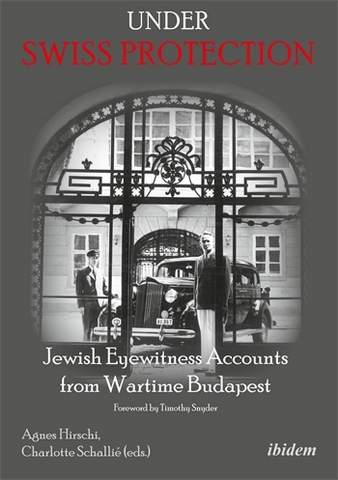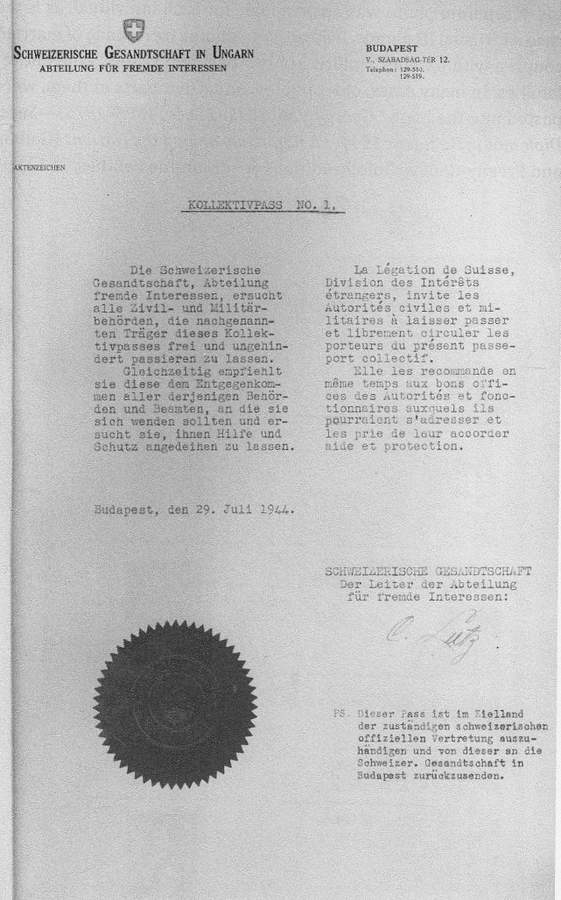Under Swiss Protection – Accounts from Wartime
Under Swiss Protection – Jewish Eyewitness Accounts from Wartime Budapest. Carl Lutz’s diplomatic wartime rescue efforts in Budapest is the topic of this book of 400 pages. Written by Agnes Hirschi (Stepdaughter of Carl Lutz) and Charlotte Schalliè (Associate Professor in Germanic Studies at UVic). The book covers 36 stories/testimonies of survivors, which includes the one of Agnes Hirschi as well. “The man who changed my life“ is her story.

As an expert on passports and their history, protection letters/passes were always included in my research. I own and have seen many such documents from righteous diplomats, not only those issued by Carls Lutz but also such from Born, Langlet, Rotta, Wallenberg etc. The interested document collector will learn about these documents more in detail, which indeed was a “life-saving paper” in German occupied Budapest in 1944.
“The movement began to provide us with false documents” says the testimony of Mordechai Laszlo Kremer, which is for me very interesting, as he describes his experience when he visited the office of the movement, where they issued fake documents. Mordechai had also one personal connection with Lutz in 1970. Lutz wrote a letter to him stating:
“…I feel sorry that I could not save more of my fellow beings, but it was a most dangerous and difficult task to negotiate with SS Eichmann as I did and with the Hungarian Nyilas government, as I did and successfully.”
The chapter “Context and Milestones of the Rescue Activities of Carl Lutz and His Team” gives a comprehensive overview of neutral powers involved in issuing protective documents in Budapest, including the International Committee of the Red Cross (ICRC), the Holy See, Spain, Portugal, Sweden and Switzerland. Turkey had also a legation in Budapest, but played only a minor role. It had no safe houses, for instance.
“Every moment, every slip of paper meant human life”
– David Gur, Ramat Gan (Israel) –
David Gur, born Endre Gròsz joined Hashomer Hatzair Zionist Youth Movement in Budapest. He was recruited to the “Workshop team”. His testimony is most interesting as we learn about the underground production of forged documents in more details.
“Diplomats are not expected to be heroes taking risks”
– Michael Vertes, Weston, CT (USA) –
Above statement is absolutely correct. That a Swiss diplomat in a foreign country, occupied by Nazi Germany takes a stand for humanity by risking his own life, not once but several times was outstanding brave! Michael Vertes was then eight years old and then known as Miklos Weisz. “I did not personally meet Carl Lutz, but I was a beneficiary of his rescue efforts and I am forever grateful to him”.

Some of the survivors still have their protection letter and so does Michael.
Another testimony comes from Englishman Prof.Geoffrey Leonard Tier who also wrote a letter to Lutz in May 1945. As Chief of the Department of Foreign Interests of the Swiss legation, Lutz represented the interests also of the U.S., Great Britain and twelve other countries that had severed formal relations with Hungary because of its alliance with Nazi Germany. Tier wrote:
“My dear Mr. Lutz, it is a difficult matter for me adequately to express the debt of gratitude which my wife and I owe you and to Mrs. Lutz for the kindness shown to us during the time you have been good enough to shelter us”
– Prof. Geoffrey Leonard Tier, Budapest 1945 –
Tier and his wife received a spot in the basement at Lutz’s residence in Jan 1945 – where around 30 people were staying at the time. The Tiers remained there until the liberation of Buda in mid-Feb 1945.
If you want to learn more about Carl Lutz and those he saved with his rescue actions from 1942 to 1944 by issuing protection letters/passes and establishing several safe houses for those in need, then I truly recommend you this book which is also available in a Kindle version.
Carl Lutz was indeed a “forgotten hero” but books like this will refresh his history and will bring his brave actions back on the surface. He will not be forgotten anymore! Well done! #carllutz
Under Swiss Protection – Jewish Eyewitness Accounts from Wartime Budapest
The life-saving documents
Letter of Protection (Schutzbrief)
Lutz drew the document up on his own initiative, which was legally and diplomatically on shaky grounds, they stated – on the letter head of the Swiss Embassy in Budapest and carrying its stamp (but no signature) – that the bearer stands under the protection of the Swiss Confederation for a later departure for Palestine. These personalized Letters of Protection were carried by its bearers and presented in case of controls and raids. In such situations this document was of live saving importance. The Swiss Letter of Protection was later copied by other countries and individuals and became immediately some of the most desired documents in the Hungarian capital, a straw to cling to for survival. Nowadays these documents are rare to find.

Collective Passport (Kollektiv-Pass)
Each person was registered twice, in the above Letter of Protection and then in this Collective Passport – an invention by Lutz for which he will later reprimanded by his superiors in Bern. Collective passports are thick binders, each containing the personal information and photos of one thousand persons. When eight of this binders are full and thus the number of 8000, as agreed upon with the Nazis, is reached, Lutz and his co-workers simply start over with another binder number 1. Two Collective Passports are in the Swiss Federal Archive.

Protective Passport (Schutzpass)
From 1942 onward, Lutz and his staff, about 20 strong, issued 300 to 400 protective passports to US and British citizens, both Jews and non-Jews, and subsequently distributed 1000 such papers to Yugoslav citizens. Very rare to find nowadays!

Comment: Researching this topic for 15+ years I never saw a protective passport issued to Yugoslav citizen myself, but I had/have 2-3 of US and British citizens.
You can download this article HERE
Under Swiss Protection – Jewish Eyewitness Accounts from Wartime Budapest
FAQ Passport History
Passport collection, passport renewal, old passports for sale, vintage passport, emergency passport renewal, same day passport, passport application, pasaporte passeport паспорт 护照 パスポート جواز سفر पासपोर्ट
1. What are the earliest known examples of passports, and how have they evolved?
The word "passport" came up only in the mid 15th Century. Before that, such documents were safe conducts, recommendations or protection letters. On a practical aspect, the earliest passport I have seen was from the mid 16th Century. Read more...
2. Are there any notable historical figures or personalities whose passports are highly sought after by collectors?
Every collector is doing well to define his collection focus, and yes, there are collectors looking for Celebrity passports and travel documents of historical figures like Winston Churchill, Brothers Grimm, Johann Wolfgang von Goethe. Read more...
3. How did passport designs and security features change throughout different periods in history, and what impact did these changes have on forgery prevention?
"Passports" before the 18th Century had a pure functional character. Security features were, in the best case, a watermark and a wax seal. Forgery, back then, was not an issue like it is nowadays. Only from the 1980s on, security features became a thing. A state-of-the-art passport nowadays has dozens of security features - visible and invisible. Some are known only by the security document printer itself. Read more...
4. What are some of the rarest and most valuable historical passports that have ever been sold or auctioned?
Lou Gehrig, Victor Tsoi, Marilyn Monroe, James Joyce, and Albert Einstein when it comes to the most expensive ones. Read more...
5. How do diplomatic passports differ from regular passports, and what makes them significant to collectors?
Such documents were often held by officials in high ranks, like ambassadors, consuls or special envoys. Furthermore, these travel documents are often frequently traveled. Hence, they hold a tapestry of stamps or visas. Partly from unusual places.
6. Can you provide insights into the stories behind specific historical passports that offer unique insights into past travel and migration trends?
A passport tells the story of its bearer and these stories can be everything - surprising, sad, vivid. Isabella Bird and her travels (1831-1904) or Mary Kingsley, a fearless Lady explorer.
7. What role did passports play during significant historical events, such as wartime travel restrictions or international treaties?
During war, a passport could have been a matter of life or death. Especially, when we are looking into WWII and the Holocaust. And yes, during that time, passports and similar documents were often forged to escape and save lives. Example...
8. How has the emergence of digital passports and biometric identification impacted the world of passport collecting?
Current modern passports having now often a sparkling, flashy design. This has mainly two reasons. 1. Improved security and 2. Displaying a countries' heritage, icons, and important figures or achievements. I can fully understand that those modern documents are wanted, especially by younger collectors.
9. Are there any specialized collections of passports, such as those from a specific country, era, or distinguished individuals?
Yes, the University of Western Sidney Library has e.g. a passport collection of the former prime minister Hon Edward Gough Whitlam and his wife Margaret. They are all diplomatic passports and I had the pleasure to apprise them. I hold e.g. a collection of almost all types of the German Empire passports (only 2 types are still missing). Also, my East German passport collection is quite extensive with pretty rare passport types.
10. Where can passport collectors find reliable resources and reputable sellers to expand their collection and learn more about passport history?
A good start is eBay, Delcampe, flea markets, garage or estate sales. The more significant travel documents you probably find at the classic auction houses. Sometimes I also offer documents from my archive/collection. See offers... As you are already here, you surely found a great source on the topic 😉
Other great sources are: Scottish Passports, The Nansen passport, The secret lives of diplomatic couriers
11. Is vintage passport collecting legal? What are the regulations and considerations collectors should know when acquiring historical passports?
First, it's important to stress that each country has its own laws when it comes to passports. Collecting old vintage passports for historical or educational reasons is safe and legal, or at least tolerated. More details on the legal aspects are here...
Does this article spark your curiosity about passport collecting and the history of passports? With this valuable information, you have a good basis to start your own passport collection.
Question? Contact me...

